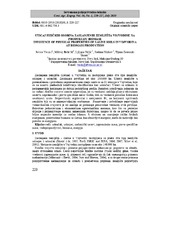Influence of physical properties of saline soils in Vojvodina at biomass production
Uticaj fizičkih osobina zaslanjenih zemljišta Vojvodine na produkciju biomase
| dc.creator | Vasin, Jovica | |
| dc.creator | Belić, Milivoj | |
| dc.creator | Nešić, Ljiljana | |
| dc.creator | Ninkov, Jordana | |
| dc.creator | Zeremski-Škorić, Tijana | |
| dc.date.accessioned | 2021-04-26T18:37:14Z | |
| dc.date.available | 2021-04-26T18:37:14Z | |
| dc.date.issued | 2010 | |
| dc.identifier.issn | 0350-2953 | |
| dc.identifier.uri | http://fiver.ifvcns.rs/handle/123456789/803 | |
| dc.description.abstract | Saline soils (halomorphic soils) are present in Vojvodina over an area of c. 150,000 ha as two soil types: solonetz and solonchak. Soil samples were taken from 25 sites in Vojvodina which, based on previous researches, had been classified as solonchaks. At representative sites (where GPS coordinates were determined) labelled as solonchaks on pedological map of Vojvodina R = 1 : 50,000, in dug soil profiles (up to 2 m depth or at ground water level) external and internal morphology was described. Soil samples in disturbed state (using pedological knife) were taken from all genetic horizons for laboratory testing of water and physical soil features. Also, soil samples in natural undisturbed state (in six replications using Kopecky cylinders) were taken from middle genetic horizons up to 1 m profile depth from the surface. Research results show that the water-physical properties are highly unfavourable. Heterogenous mechanical composition, i.e. texture difference in pedological profile is prominent with all solonchak profiles structured A/E-Bt-BC (in Bt horizont 11.74 % more clay as compared to the higher A/E horizont) and solonetz (in Bt horizont 15.68 % more clay as compared to the higher A/E horizont). Bt,na solonetz horizon with silt, sand and clay ratio 38%:23%:39% was the most deviant from the agronomically most favourable ratio 40%:40%:20%. Bulk density average values of solonchaks profile structur A/E-Bt-BC decrease with depth. This trend differs from most other soil types. Soil profiles classified as solonchaks and solonetzs show high values of specific mass, which can be interpreted with low organic matter content. Average filtration capacity of the tested halomorphic soils is wide-ranged, from a moderately fast in subsurface AC horizont of solonchak profile structure A-AC-C, to a slow one in Bt horizon of solonchak profile structure A/E-Bt-BC. Surface A horizon of solonchak profile structure A-AC-C is water impermeable, and it is known that the speed of filtration (water permeability) down the soil profile depth is determined by horizon, i.e. the layer with the least permeability. Subsurface argiluvic and natric Bt,na horizons of the tested soils were of the most unfavourable water-physical properties. Knowing and improving unfavourable water-physical properties is of importance for increasing low production ability of the surfaces under saline soils (average hay yield from extensive pastures was 0.5-1.5 t/ha, and from meadows up to 2 t/ha). Yield of plant organic matter for animal feed could be increased by using relatively simple and inexpensive agrotechnical measures, such as harrowing in the spring and top dressing with mineral fertilizers. Considering the decrease in reserves of fossil fuel resources, the biomass produced on saline soils, as a renewable resource, could partially satisfy the demand for energy. | en |
| dc.description.abstract | Zaslanjena zemljišta (slatine) u Vojvodini su zastupljena preko dva tipa zemljišta: solonjec i solončak. Zauzimaju površinu od oko 150.000 ha. Uzorci zemljišta u poremećenom i prirodnom neporemećenom stanju uzeti su sa 25 lokacija u Vojvodini, koja su na osnovu prethodnih istraživanja klasifikovana kao solončaci. Uzorci su uzimani iz pedogenetskih horizonata po dubini pedološkog profila. Rezultati istraživanja pokazuju da su vodna i fizička svojstva izrazito nepovoljna, jer su vrednosti sadržaja gline u teksturnom sastavu, zapreminske i prave specifične mase visoke, dok su vrednosti prosečne filtracione sosobnosti niske. Potpovršinski argiluvični i natrijumski Bt, na horizonti ispitivanih zemljišta bili su sa najnepovoljnijim osobinama. Poznavanje i poboljšanje nepovoljnih vodno-fizičkih svojstava je od značaja za podizanje proizvodne vrednosti ovih površina. Relativno jednostavnim i ekonomičnim agrotehničkim merama, kao što su prolećno drljanje i prihranjivanje azotnim mineralnim đubrivima, mogao bi da se poveća prinos biljne organske materije za stočnu ishranu. S obzirom na smanjenje zaliha fosilnih energenata, proizvedena biomasa sa slatina, kao obnovljivi energent, može da zadovolji deo potreba za energijom. | sr |
| dc.publisher | Nacionalno naučno društvo za poljoprivrednu tehniku, Novi Sad | |
| dc.rights | openAccess | |
| dc.source | Savremena poljoprivredna tehnika | |
| dc.subject | solonchak | en |
| dc.subject | solonetz | en |
| dc.subject | texture | en |
| dc.subject | bulk density | en |
| dc.subject | particle density | en |
| dc.subject | water filtration | en |
| dc.subject | biomass | en |
| dc.subject | energy | en |
| dc.subject | solončak | sr |
| dc.subject | solonjec | sr |
| dc.subject | mehanički sastav | sr |
| dc.subject | zapreminska masa | sr |
| dc.subject | prava specifična masa | sr |
| dc.subject | vodopropustljivost | sr |
| dc.subject | biomasa | sr |
| dc.subject | energija | sr |
| dc.title | Influence of physical properties of saline soils in Vojvodina at biomass production | en |
| dc.title | Uticaj fizičkih osobina zaslanjenih zemljišta Vojvodine na produkciju biomase | sr |
| dc.type | article | |
| dc.rights.license | ARR | |
| dc.citation.epage | 227 | |
| dc.citation.issue | 3 | |
| dc.citation.other | 36(3): 220-227 | |
| dc.citation.rank | M51 | |
| dc.citation.spage | 220 | |
| dc.citation.volume | 36 | |
| dc.identifier.fulltext | http://fiver.ifvcns.rs/bitstream/id/1646/800.pdf | |
| dc.identifier.rcub | https://hdl.handle.net/21.15107/rcub_fiver_803 | |
| dc.type.version | publishedVersion |


